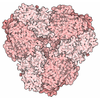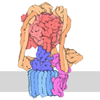+ データを開く
データを開く
- 基本情報
基本情報
| 登録情報 | データベース: PDB / ID: 9dnt | |||||||||
|---|---|---|---|---|---|---|---|---|---|---|
| タイトル | Cryo-EM structure of Tom1 (S. cerevisiae) | |||||||||
 要素 要素 | E3 ubiquitin-protein ligase TOM1 | |||||||||
 キーワード キーワード | TRANSFERASE / ubiquitin / ubiquitylation complex | |||||||||
| 機能・相同性 |  機能・相同性情報 機能・相同性情報endonucleolytic cleavage in 5'-ETS of tricistronic rRNA transcript (SSU-rRNA, 5.8S rRNA, LSU-rRNA) / endonucleolytic cleavage to generate mature 5'-end of SSU-rRNA from (SSU-rRNA, 5.8S rRNA, LSU-rRNA) / HECT-type E3 ubiquitin transferase / nucleocytoplasmic transport / cleavage in ITS2 between 5.8S rRNA and LSU-rRNA of tricistronic rRNA transcript (SSU-rRNA, 5.8S rRNA, LSU-rRNA) / nucleus organization / regulation of cell size / Antigen processing: Ubiquitination & Proteasome degradation / mRNA transport / endonucleolytic cleavage in ITS1 to separate SSU-rRNA from 5.8S rRNA and LSU-rRNA from tricistronic rRNA transcript (SSU-rRNA, 5.8S rRNA, LSU-rRNA) ...endonucleolytic cleavage in 5'-ETS of tricistronic rRNA transcript (SSU-rRNA, 5.8S rRNA, LSU-rRNA) / endonucleolytic cleavage to generate mature 5'-end of SSU-rRNA from (SSU-rRNA, 5.8S rRNA, LSU-rRNA) / HECT-type E3 ubiquitin transferase / nucleocytoplasmic transport / cleavage in ITS2 between 5.8S rRNA and LSU-rRNA of tricistronic rRNA transcript (SSU-rRNA, 5.8S rRNA, LSU-rRNA) / nucleus organization / regulation of cell size / Antigen processing: Ubiquitination & Proteasome degradation / mRNA transport / endonucleolytic cleavage in ITS1 to separate SSU-rRNA from 5.8S rRNA and LSU-rRNA from tricistronic rRNA transcript (SSU-rRNA, 5.8S rRNA, LSU-rRNA) / Neutrophil degranulation / ubiquitin-protein transferase activity / ubiquitin protein ligase activity / mitotic cell cycle / ubiquitin-dependent protein catabolic process / protein ubiquitination / nucleolus / nucleus / cytoplasm 類似検索 - 分子機能 | |||||||||
| 生物種 |  | |||||||||
| 手法 | 電子顕微鏡法 / 単粒子再構成法 / クライオ電子顕微鏡法 / 解像度: 3 Å | |||||||||
 データ登録者 データ登録者 | Warner, K.M. / Hunkeler, M. / Baek, K. / Roy Burman, S.S. / Fischer, E.S. | |||||||||
| 資金援助 |  米国, 2件 米国, 2件
| |||||||||
 引用 引用 |  ジャーナル: Cell Rep / 年: 2025 ジャーナル: Cell Rep / 年: 2025タイトル: Structural ubiquitin contributes to K48 linkage specificity of the HECT ligase Tom1. 著者: Katrina Warner / Moritz Hunkeler / Kheewoong Baek / Anna Schmoker / Shourya S Roy Burman / Daan Overwijn / Cyrus Jin / Katherine A Donovan / Eric S Fischer /  要旨: Homologous to E6AP C terminus (HECT) ubiquitin ligases play key roles in essential pathways such as DNA repair, cell cycle control, or protein quality control. Tom1 is one of five HECT ubiquitin E3 ...Homologous to E6AP C terminus (HECT) ubiquitin ligases play key roles in essential pathways such as DNA repair, cell cycle control, or protein quality control. Tom1 is one of five HECT ubiquitin E3 ligases in budding yeast S. cerevisiae and is prototypical for a ligase with pleiotropic functions such as ubiquitin chain amplification, orphan quality control, and DNA damage response. Structures of full-length HECT ligases, including the Tom1 ortholog HUWE1, have been reported, but how domains beyond the conserved catalytic module contribute to catalysis remains largely elusive. Here, through cryoelectron microscopy (cryo-EM) snapshots of Tom1 during an active ubiquitination cycle, we demonstrate that the extended domain architecture directly contributes to activity. We identify a Tom1-ubiquitin architecture during ubiquitination involving a non-canonical ubiquitin-binding site in the solenoid shape of Tom1. We demonstrate that this ubiquitin-binding site coordinates a structural ubiquitin contributing to the fidelity of K48 poly-ubiquitin chain assembly. | |||||||||
| 履歴 |
|
- 構造の表示
構造の表示
| 構造ビューア | 分子:  Molmil Molmil Jmol/JSmol Jmol/JSmol |
|---|
- ダウンロードとリンク
ダウンロードとリンク
- ダウンロード
ダウンロード
| PDBx/mmCIF形式 |  9dnt.cif.gz 9dnt.cif.gz | 965.9 KB | 表示 |  PDBx/mmCIF形式 PDBx/mmCIF形式 |
|---|---|---|---|---|
| PDB形式 |  pdb9dnt.ent.gz pdb9dnt.ent.gz | 796.6 KB | 表示 |  PDB形式 PDB形式 |
| PDBx/mmJSON形式 |  9dnt.json.gz 9dnt.json.gz | ツリー表示 |  PDBx/mmJSON形式 PDBx/mmJSON形式 | |
| その他 |  その他のダウンロード その他のダウンロード |
-検証レポート
| 文書・要旨 |  9dnt_validation.pdf.gz 9dnt_validation.pdf.gz | 1.3 MB | 表示 |  wwPDB検証レポート wwPDB検証レポート |
|---|---|---|---|---|
| 文書・詳細版 |  9dnt_full_validation.pdf.gz 9dnt_full_validation.pdf.gz | 1.3 MB | 表示 | |
| XML形式データ |  9dnt_validation.xml.gz 9dnt_validation.xml.gz | 75.1 KB | 表示 | |
| CIF形式データ |  9dnt_validation.cif.gz 9dnt_validation.cif.gz | 116.4 KB | 表示 | |
| アーカイブディレクトリ |  https://data.pdbj.org/pub/pdb/validation_reports/dn/9dnt https://data.pdbj.org/pub/pdb/validation_reports/dn/9dnt ftp://data.pdbj.org/pub/pdb/validation_reports/dn/9dnt ftp://data.pdbj.org/pub/pdb/validation_reports/dn/9dnt | HTTPS FTP |
-関連構造データ
| 関連構造データ |  47058MC  9dnsC M: このデータのモデリングに利用したマップデータ C: 同じ文献を引用 ( |
|---|---|
| 類似構造データ | 類似検索 - 機能・相同性  F&H 検索 F&H 検索 |
- リンク
リンク
- 集合体
集合体
| 登録構造単位 | 
|
|---|---|
| 1 |
|
- 要素
要素
| #1: タンパク質 | 分子量: 377412.500 Da / 分子数: 1 / 由来タイプ: 組換発現 由来: (組換発現)  遺伝子: TOM1, SSR2, YDR457W, D8035.1 / 発現宿主:  Trichoplusia ni (イラクサキンウワバ) / 参照: UniProt: Q03280, HECT-type E3 ubiquitin transferase Trichoplusia ni (イラクサキンウワバ) / 参照: UniProt: Q03280, HECT-type E3 ubiquitin transferase |
|---|---|
| Has protein modification | N |
-実験情報
-実験
| 実験 | 手法: 電子顕微鏡法 |
|---|---|
| EM実験 | 試料の集合状態: PARTICLE / 3次元再構成法: 単粒子再構成法 |
- 試料調製
試料調製
| 構成要素 | 名称: Full length structure, S. cerevisiae Tom1 / タイプ: COMPLEX / 詳細: Tom1 closed-ring conformation, stabilized / Entity ID: all / 由来: RECOMBINANT | |||||||||||||||||||||||||
|---|---|---|---|---|---|---|---|---|---|---|---|---|---|---|---|---|---|---|---|---|---|---|---|---|---|---|
| 分子量 | 値: 0.376 MDa / 実験値: NO | |||||||||||||||||||||||||
| 由来(天然) | 生物種:  | |||||||||||||||||||||||||
| 由来(組換発現) | 生物種:  Trichoplusia ni (イラクサキンウワバ) Trichoplusia ni (イラクサキンウワバ) | |||||||||||||||||||||||||
| 緩衝液 | pH: 7.2 詳細: 30 mM HEPES pH 7.2, 200 mM NaCl, 2 mM TCEP, 0.3 mM CHAPSO | |||||||||||||||||||||||||
| 緩衝液成分 |
| |||||||||||||||||||||||||
| 試料 | 濃度: 4.8 mg/ml / 包埋: NO / シャドウイング: NO / 染色: NO / 凍結: YES | |||||||||||||||||||||||||
| 試料支持 | 詳細: 60 seconds / hold time: 10 seconds / Current: 15 mA / グリッドの材料: COPPER / グリッドのサイズ: 300 divisions/in. / グリッドのタイプ: Quantifoil R1.2/1.3 | |||||||||||||||||||||||||
| 急速凍結 | 装置: LEICA EM GP / 凍結剤: ETHANE / 湿度: 90 % / 凍結前の試料温度: 283.15 K 詳細: CHAPSO detergent added to final conc. of 0.3 mM. Sample applied twice. |
- 電子顕微鏡撮影
電子顕微鏡撮影
| 実験機器 |  モデル: Titan Krios / 画像提供: FEI Company |
|---|---|
| 顕微鏡 | モデル: TFS KRIOS |
| 電子銃 | 電子線源:  FIELD EMISSION GUN / 加速電圧: 300 kV / 照射モード: FLOOD BEAM FIELD EMISSION GUN / 加速電圧: 300 kV / 照射モード: FLOOD BEAM |
| 電子レンズ | モード: BRIGHT FIELD / 倍率(公称値): 105000 X / 最大 デフォーカス(公称値): 2200 nm / 最小 デフォーカス(公称値): 1100 nm / Cs: 2.7 mm / C2レンズ絞り径: 50 µm / アライメント法: COMA FREE |
| 試料ホルダ | 凍結剤: NITROGEN 試料ホルダーモデル: FEI TITAN KRIOS AUTOGRID HOLDER |
| 撮影 | 平均露光時間: 2.8 sec. / 電子線照射量: 53.687 e/Å2 フィルム・検出器のモデル: GATAN K3 BIOQUANTUM (6k x 4k) 撮影したグリッド数: 1 / 実像数: 11583 |
| 電子光学装置 | エネルギーフィルター名称: GIF Bioquantum / エネルギーフィルタースリット幅: 20 eV |
- 解析
解析
| EMソフトウェア |
| ||||||||||||||||||||||||||||||||||||||||||||
|---|---|---|---|---|---|---|---|---|---|---|---|---|---|---|---|---|---|---|---|---|---|---|---|---|---|---|---|---|---|---|---|---|---|---|---|---|---|---|---|---|---|---|---|---|---|
| CTF補正 | タイプ: PHASE FLIPPING AND AMPLITUDE CORRECTION | ||||||||||||||||||||||||||||||||||||||||||||
| 粒子像の選択 | 選択した粒子像数: 4216890 | ||||||||||||||||||||||||||||||||||||||||||||
| 3次元再構成 | 解像度: 3 Å / 解像度の算出法: FSC 0.143 CUT-OFF / 粒子像の数: 451216 / 対称性のタイプ: POINT | ||||||||||||||||||||||||||||||||||||||||||||
| 原子モデル構築 | B value: 121 | ||||||||||||||||||||||||||||||||||||||||||||
| 原子モデル構築 | Source name: AlphaFold / タイプ: in silico model | ||||||||||||||||||||||||||||||||||||||||||||
| 拘束条件 |
|
 ムービー
ムービー コントローラー
コントローラー

















 PDBj
PDBj










